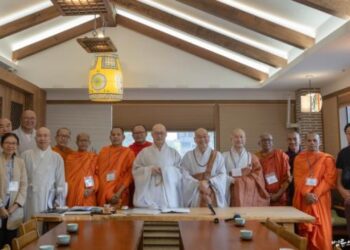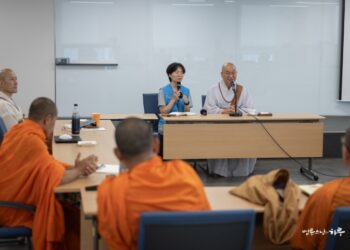Oct 24, 2024 – North Korea Expert Meeting, Dharma Q&A Reorganization Discussion, Meeting with Pastor Kim Min-hae
Hello. A new day has dawned at the Seoul Jungto Center.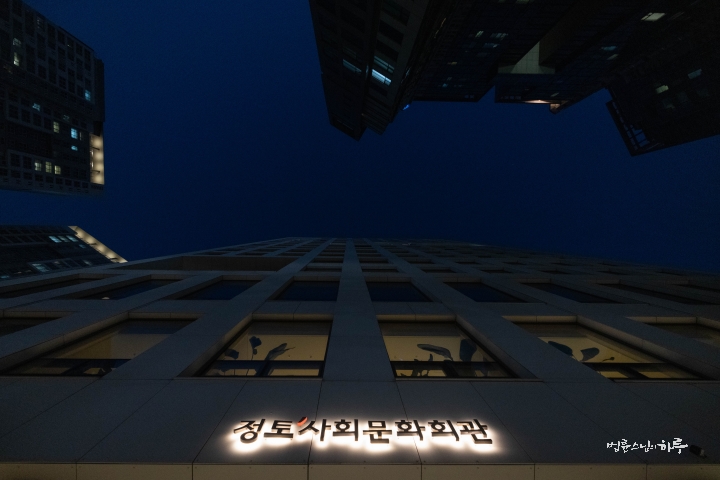
After completing his early morning practice and meditation, Sunim began the day with a breakfast meeting with North Korea experts at 7 AM. After having breakfast prepared by the Peace Foundation staff, he examined the living conditions of North Korean residents and checked changes in exchange rates and food prices.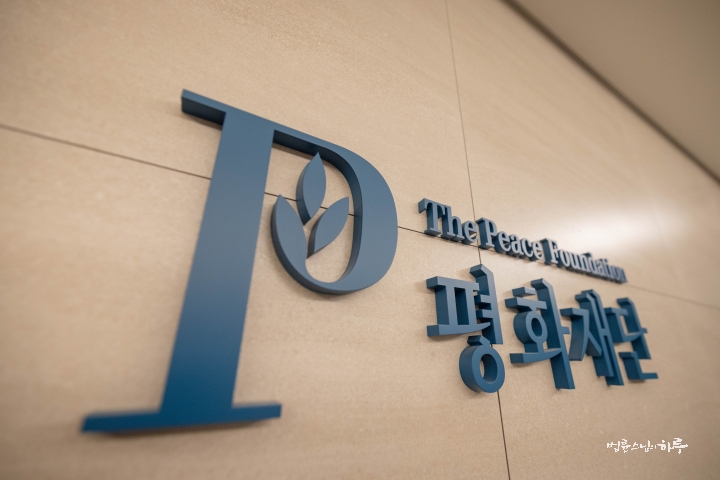
Following this, there were extensive discussions about recent events that have intensified tensions in inter-Korean relations, including an analysis of the unmanned aerial vehicle that infiltrated Pyongyang’s airspace, and the issue of North Korea dispatching troops to the Russia-Ukraine war.
At 10 AM, officials from the newly elected Seoul Superintendent of Education’s office visited to discuss the protection of students’ rights and teacher authority. After this meeting, from 11 AM, a preparation meeting for the 34th India Pilgrimage was held in the Peace Foundation’s 10th-floor conference room. Dharma teachers and staff participating in the pilgrimage also attended both online and in-person.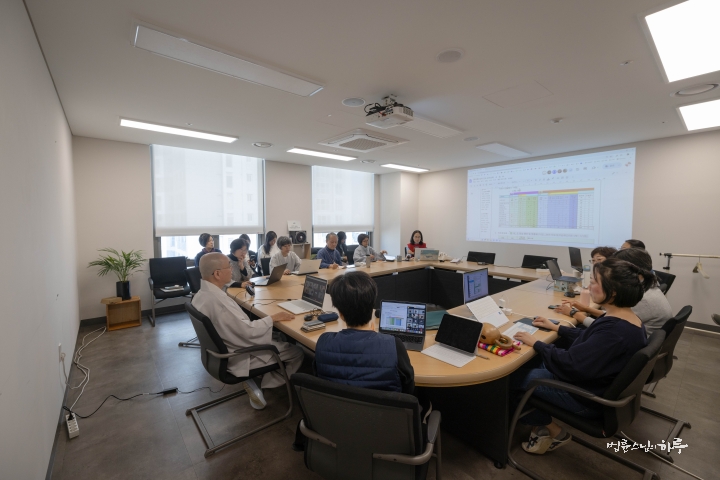
They reported on the additional participants registered last week and asked Sunim for guidance on matters to be adjusted for each date in the overall pilgrimage schedule. Sunim provided direction from the pilgrims’ perspective, emphasizing that the pilgrimage should be conducted efficiently and meaningfully rather than for the convenience of the staff.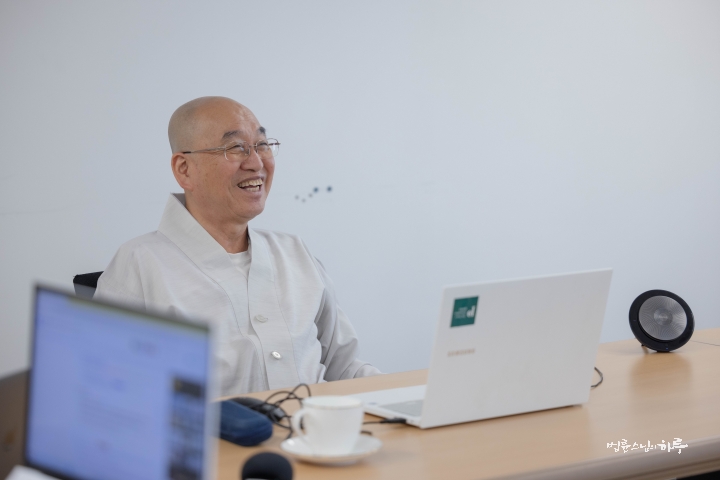
The meeting concluded at 12:20 PM, followed by lunch. At 1 PM, a meeting was held to discuss reorganizing the Dharma Q&A. It has been over three years since the live Friday Dharma Q&A program was introduced after the COVID-19 pandemic. About 5,000 people connect to the live broadcast to watch the Dharma Q&A every week. To evaluate the advantages and disadvantages of the online transition and plan for an improved program, all the operational managers from each department gathered to seek Sunim’s advice.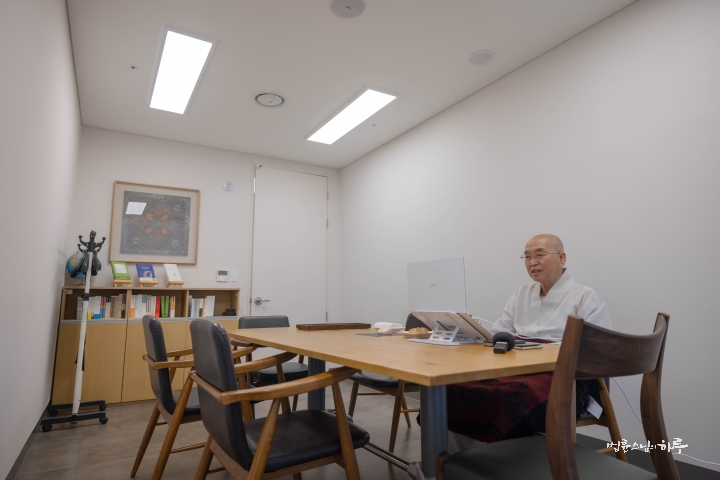
The operational managers had prepared various questions to seek Sunim’s advice on the direction for reorganizing the Dharma Q&A lectures. First, the executive director of Jungto Society asked Sunim about the purpose of the Dharma Q&A.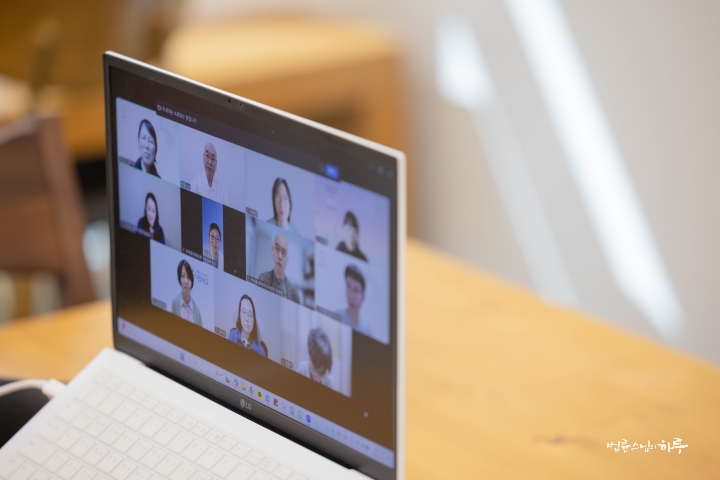
What Is the Purpose of Dharma Q&A?
Secondly, Buddhism has many philosophical elements. For those who enjoy academic pursuits, the profound and logical Buddhist philosophy is extremely attractive, but it’s too difficult for ordinary people. Moreover, knowing a lot about Buddhist philosophy doesn’t necessarily resolve one’s suffering.
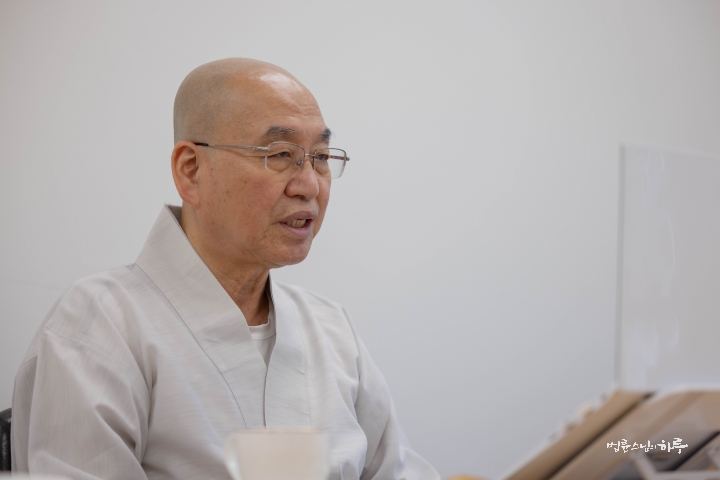
However, when we examine the Buddha’s teachings closely, we find that the fundamental purpose of Buddhist practice is to attain nirvana. Nirvana refers to a state free from suffering. In other words, the ultimate goal of Buddhist practice is to reach a state without suffering. Therefore, the purpose of Dharma Q&A is to return to the Buddha’s original teachings. Looking back to the time of the Buddha, we see that when someone was suffering, the Buddha would guide them to realize the cause of their suffering. He would help them identify and eliminate the cause of suffering to reach a state free from suffering. This is the Four Noble Truths.
When the Buddha engaged in dialogue with people, their questions were essentially expressions of their own suffering. People would come to the Buddha saying, “I want to be free from this suffering.” The Buddha would then ask, “Why are you suffering?” They would explain their perceived reasons for suffering, but most people are unable to accurately identify the true cause. Through multiple conversations with the Buddha, they would come to understand the real cause of their suffering and realize that it was not something worth suffering over.
Most people think of a Dharma talk as a discussion about Buddhist philosophy. However, at its core, a Dharma talk is not about discussing Buddhist doctrine, ideas, or culture. A true Dharma talk occurs when a suffering person’s distress is alleviated through conversation. Similarly, Dharma Q&A is a dialogue aimed at freeing people from suffering, regardless of whether it concerns parent-child relationships, marital issues, money, desires, or anything else. The purpose of Dharma Q&A is to guide those who are suffering away from their distress. Therefore, it is both a national happiness movement to increase the well-being of citizens and a propagation of the Buddha’s teachings.
Questions continued to come in.
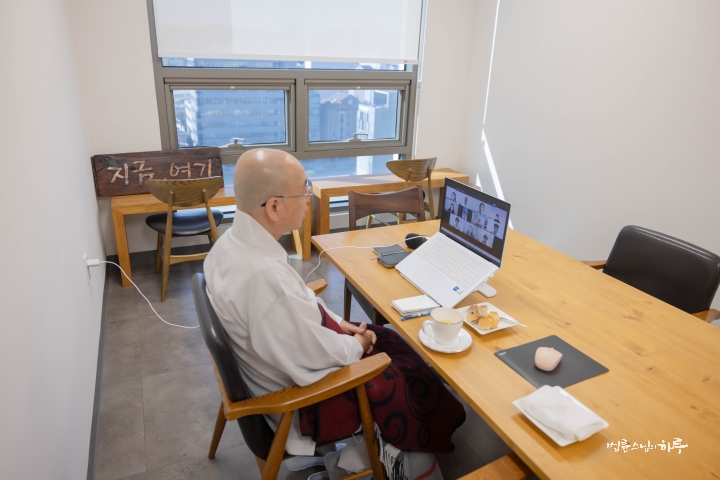
“How should we brand Venerable Pomnyun Sunim’s Dharma Q&A? To enhance the long-term value of Dharma Q&A, what direction should we take when producing YouTube videos?”
“For Dharma Q&A to truly shine, it’s better to keep the dialogue simple and direct rather than providing lengthy explanations. However, people with anxious mindsets often can’t resolve their concerns through brief Q&A sessions. In many cases, longer explanations are necessary. It’s best not to upload questions about Buddhist doctrine to YouTube if possible. The true value of Dharma Q&A lies in short, conversational exchanges. Discussions about intellectual topics don’t align with the value of Dharma Q&A. The essence of Dharma Q&A is in conversations that spark realizations like, ‘Ah, I see it can be thought of that way.’ I focus on guiding the questioner to have realizations, so emphasizing this aspect can help maintain the vitality of Dharma Q&A for a long time. However, if explanations are too brief, people may not understand, and if they’re too long, it becomes more like an interpretive commentary.”
The final question was about the future of Dharma Q&A.
Can Artificial Intelligence Technology Replace Venerable Pomnyun Sunim’s Dharma Q&A?
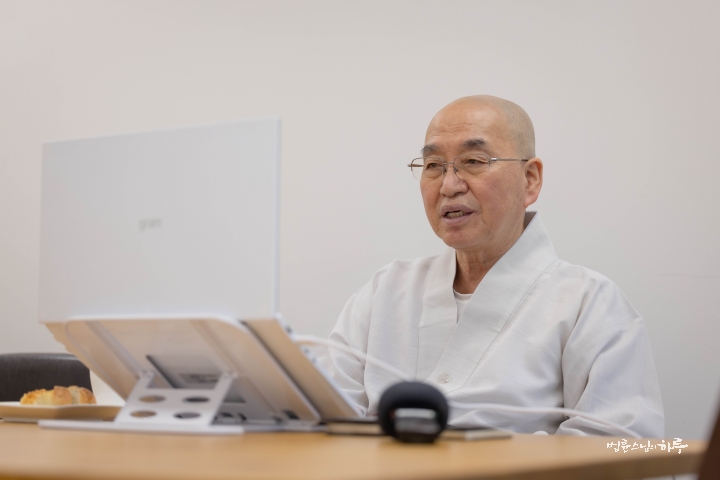
“It’s not important that I continue doing Dharma Q&A indefinitely. I think Dharma Q&A should conclude after about 10,000 sessions. Even if I’m still alive after 10,000 sessions, we should wrap it up to some extent, and from then on, people can solve problems by referring to those sessions. It’s not right to think that everyone needs to ask me questions individually. Even the Buddha’s teachings ended with what he said during his lifetime, and we now use those teachings as a guide for how to live our lives. We can’t include all the words of every teacher after the Buddha in the scriptures, can we?
There have been suggestions that by using the data from about 10,000 Dharma Q&A sessions with AI technology, we could continue to provide a Dharma Q&A service similar to, though not exactly the same as, me doing it directly. This approach risks turning the Buddha’s teachings into mere logic or knowledge. But I think this might be unavoidable in the future. When we recorded the Tripitaka, it had the side effect of turning the Buddha’s teachings into knowledge, but it also had the advantage of spreading the teachings. I think we might have to accept both these advantages and disadvantages. This is an issue that needs to be examined more closely.”
The operational managers asked questions on various topics including branding Dharma Q&A, ways to improve the program, whether to establish a Dharma Q&A platform, methods for receiving questions, ways to expand online audiences, and the future of Dharma Q&A.
After the conversation, Sunim provided some concluding remarks. While we quickly transitioned online due to the COVID-19 pandemic, as time has passed, both advantages and disadvantages have become apparent. Recently, many suggestions have been made to complement the shortcomings of online sessions with various offline proposals, which are being reconsidered. Sunim encouraged us to continuously research and adapt to societal changes.
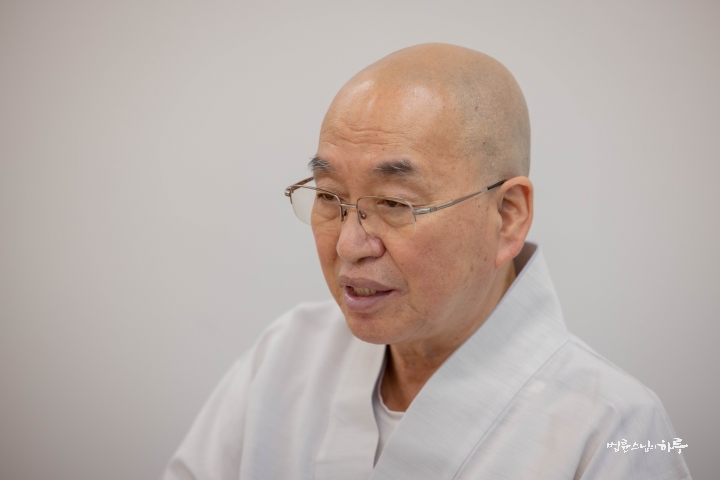
“If there are things that need to be corrected in the current Dharma Q&A lectures, we can make those changes and run them as pilot programs. If there are pros and cons, we can try different approaches and evaluate the results to make adjustments. Fundamentally, Dharma Q&A is a dialogue between me and the questioner, so there can’t be major changes in that aspect. However, there is a difference between having a conversation in person at a lecture hall and having one online. In person, the Q&A can happen quickly, but online, it’s often more like me listening to a question and then answering it, rather than a true back-and-forth dialogue. In person, I can see the person’s face, so I can ask various questions, and the questioner can interject, but online, it’s a bit harder for the questioner to interject. In that sense, while online sessions have the advantage of reaching many people at once and spreading widely, they lack some of the fun elements and natural flow of the Q&A in the details. However, some people say that talking online feels less stressful because it seems like they’re having a one-on-one consultation with me. Some say that when they ask questions in front of an audience, they’re so nervous that they don’t even remember what they said, and they feel dazed even after the conversation ends. But when it’s online, they say they can fully understand what’s being said. It seems there are both advantages and disadvantages. Let’s continue to discuss and find ways to improve.”
The meeting to revamp Dharma Q&A ended at 2:30 PM. Following this, at 3 PM, Namal, who had served as a volunteer representative when JTS provided emergency aid in Sri Lanka, came to visit. He was in Korea for a month and wanted to express his gratitude to Sunim. Namal brought tea and natural palm sugar directly from Sri Lanka, along with a handwritten letter.
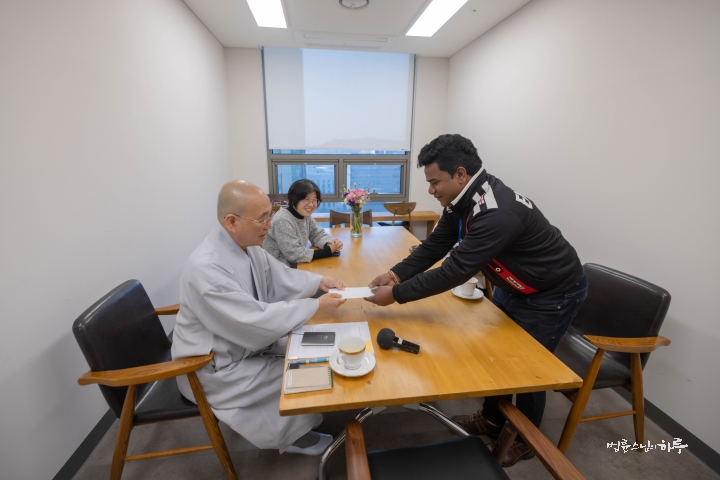
“Thank you so much for helping our country,”
“Thank you for volunteering in Sri Lanka. The Korean volunteers also spoke very highly of you.”
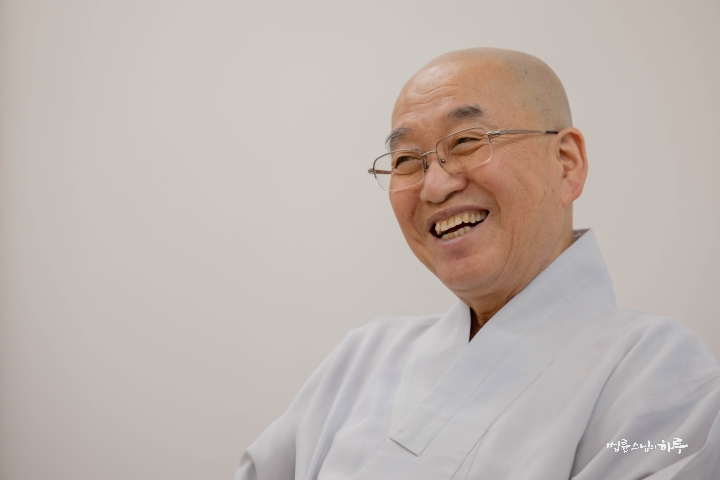
Namal suggested that next year, it would be good to address housing issues for homeless people and provide medical support for cancer patients. Sunim explained JTS’s support principles using the example of an ongoing sustainable development project in Bhutan.
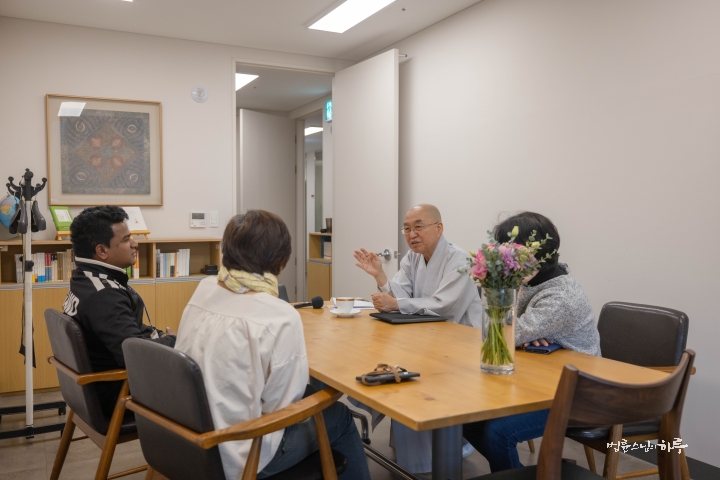
“When building houses, it must be based on the consensus of the villagers. We should only provide support when everyone in the village agrees that a particular family truly deserves help. This way, the village can participate without complaints.
Also, when providing support, we should follow these principles. First, we should create something useful while spending as little money as possible. Second, local residents should participate collectively, and the benefits should be evenly distributed. Third, we should use local materials and utilize local skills as much as possible. Only in this way can residents become self-reliant, and the project can have a positive impact on the entire village community.”
“Yes. It would be great if you could meet our president too. I think he would appreciate your ideas on how to manage the country and plan for the future.” (laughs)
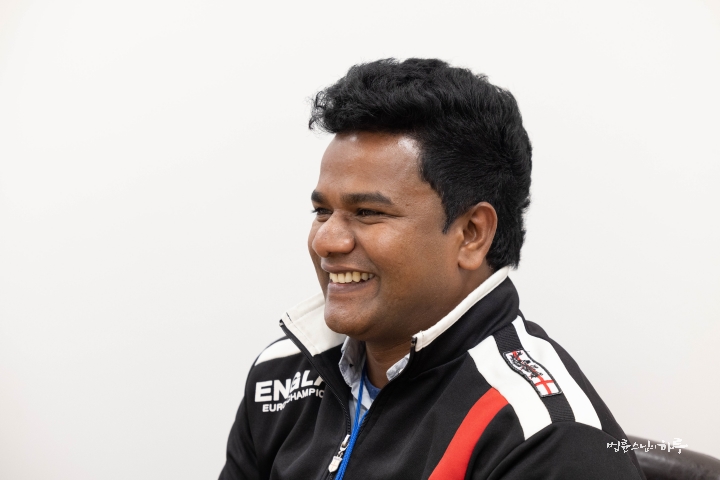
After an hour of conversation, they agreed to meet next time at the Dubuk Retreat Center and concluded the meeting.
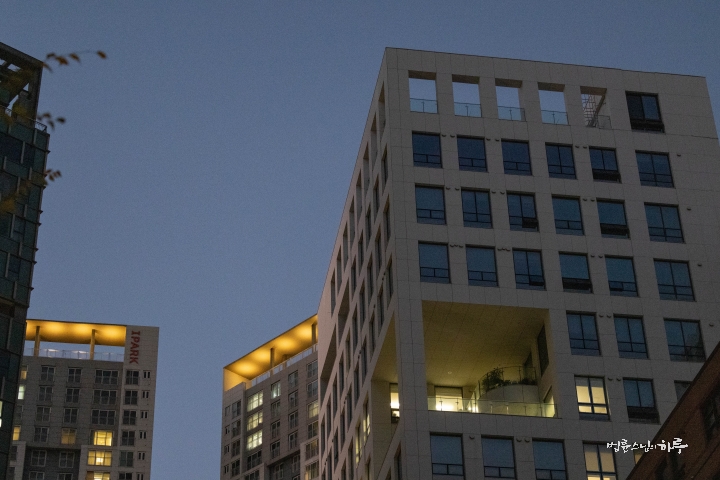
At 4 PM, Pastor Kim Min-hae and his group, who are running a community called ‘Love-filled Village Learning Center’ in Suncheon, Jeollanam-do, visited Sunim for a conversation. The pastor said he wanted to seek advice from Sunim, who had pioneered the path of civilization transformation movement, as they are attempting to start such a movement.
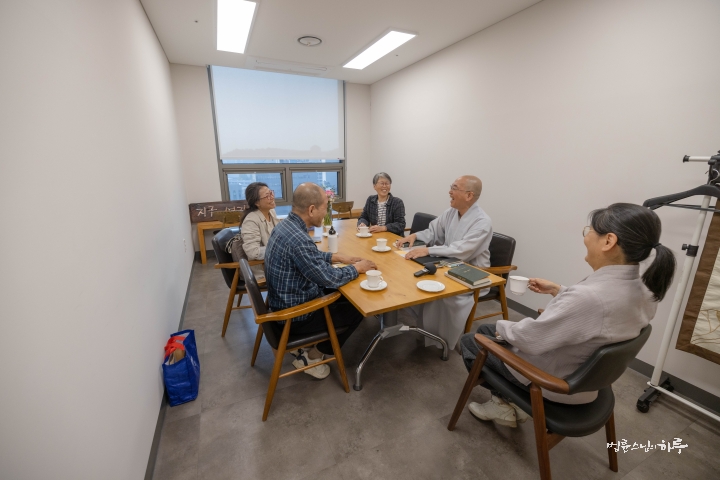
First, Pastor Kim Min-hae explained why he came to see Sunim.
“Thirty years ago, we started a new movement within Protestantism called ‘Living like Jesus’. At that time, you were already thinking about civilization transformation and carrying out a new movement. Now, 30 years later, it seems we are following the path you’ve been leading. We are trying to attempt a civilization transformation in Suncheon, Jeollanam-do, focusing more on ecological values, which we call ‘ecological civilization’. We’ve come here to seek your advice.”
“You’re too kind. Just carry on with your good intentions.” (laughs)
The pastor then asked specific questions to seek Sunim’s advice.
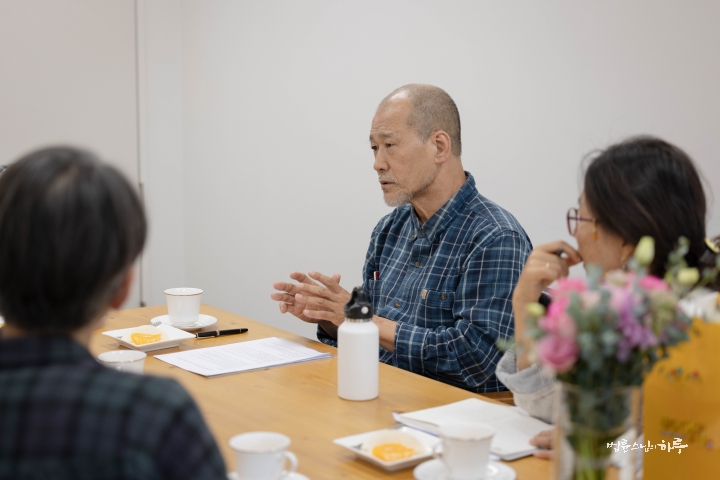
How Can We Create an Ecological Movement Model That Involves Both the Public and the Government?
If you want to carry out a purely ecological environmental movement, you need to live frugally like Pastor Lee Hyun-joo. You should let go of the idea of achieving any results. You should live that way first, and if there are others who agree, you can live together. If you want to spread this movement a bit more in reality, you end up developing a little out of necessity. Because when you try to do something, you need a place, you need manpower. Also, as you work, there may be cases where you need to travel abroad, and then you create the problem of contributing to carbon dioxide emissions by flying back and forth while carrying out your activities.
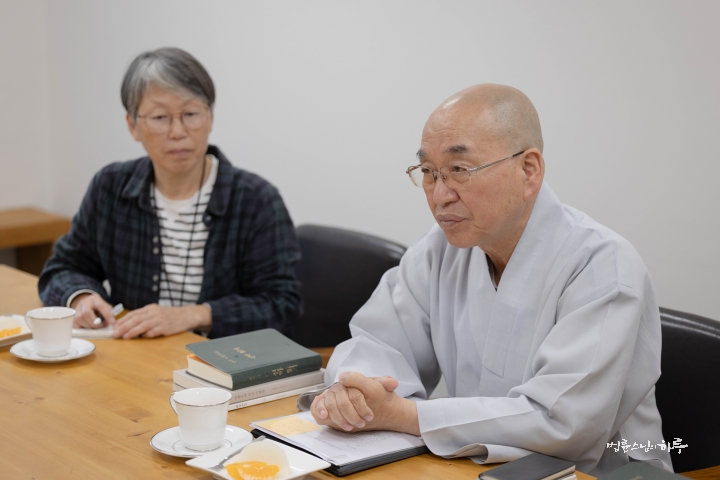
If we try to maintain perfect purity while collaborating with government agencies for ecological movements, the partnership will eventually fall apart. Therefore, it’s necessary to maintain an attitude that “doing something is better than doing nothing,” striving to uphold ecological principles while also accommodating government requests to some extent. This approach allows for steady progress on this path.
To sustain an ecological movement, you need both faculty and staff. This requires space for them to work, which incurs labor costs and rent. We need to find ways to address these issues. To overcome these challenges, I introduced a volunteer system. For 30 years, we’ve adhered to the principle of resolving issues through volunteerism rather than hiring employees. However, while this was feasible when we were small, it’s becoming increasingly difficult to operate solely on volunteers as we grow larger. When building the Jungto Social and Cultural Center, we faced the dilemma of needing staff to manage the building while maintaining our principle of “not hiring employees.” We initially agreed to resolve this internally with volunteers and proceeded with construction. However, upon completion, it became clear that the volunteer approach wasn’t sufficient. As a result, we couldn’t hold an opening ceremony because I had declared that I wouldn’t enter the building if we couldn’t manage it with volunteers. We eventually delayed the opening until we could recruit and train enough volunteers to maintain the building. Now, the building is operated entirely by volunteers. Typically, a building of this size requires at least seven professional staff members to manage. However, Jungto Society needed 150 volunteers to manage the building, as they work part-time shifts. From a manpower perspective, this is highly inefficient.
As an organization grows, it becomes increasingly difficult to maintain its principles. One of the challenges Jungto Society faces now is the growing demand for Sunim’s videos. Video editing and broadcasting require professional skills, and volunteers alone can’t meet this demand. Publishing books has also become challenging to manage solely with volunteers. As we continue to expand our activities, it’s becoming harder to adhere to the principle of volunteer-based operations. Overseas, as our projects grow, there’s an increasing demand for paid staff. It’s even more difficult to find volunteers in poorer countries. While local volunteers are dedicating themselves, these unspoken demands persist. Some criticize, saying, “With just a few employees, we could run projects more effectively. How can you expect to find volunteers in countries where people are struggling to make ends meet?”
As we expand our activities, it becomes difficult to maintain our principles, and to operate efficiently, we may need to modify our principles slightly. So now, Jungto Society is faced with two options: either maintain our principles without expanding, or slightly modify our principles to expand our good work. The first challenge Jungto Society faced was operating the Jungto Social and Cultural Center. The second was overseas relief work. The third is video editing and publishing. Operating with volunteers leads to frequent personnel changes, resulting in decreased efficiency, lack of continuity, and weaker expertise. All these factors make it difficult to operate projects while adhering to the volunteer principle, thus limiting the expansion of our activities.
Looking at the distant future, maintaining principles is more valuable. Jesus, for instance, lived a short life adhering to his principles, which allowed his life to have a profound impact on future generations. If Jesus had lived to 80, how could he have maintained all his principles? While it’s possible to uphold principles when young, living to 80 would likely require all sorts of compromises. Similarly, from a long-term perspective, maintaining principles, even if it means downsizing, can provide more hope for future generations. However, in reality, expanding seems better because it allows for more efficient good work. After all, any environmental movement needs to spread to have a tangible impact.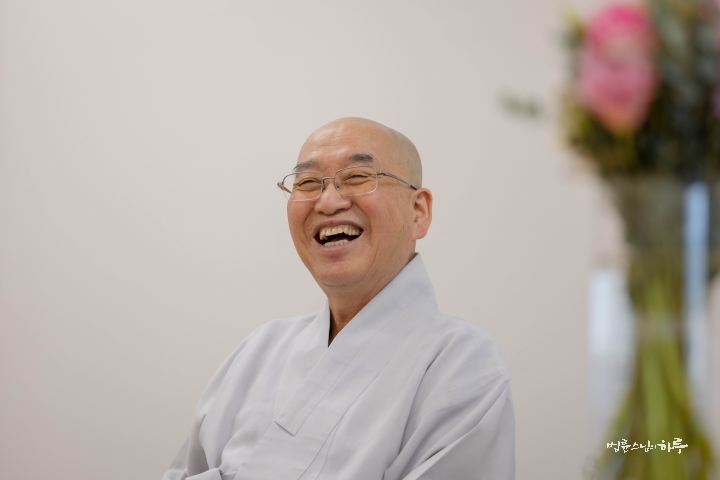
When expanding ecological movements, some compromise is necessary. This doesn’t mean completely abandoning principles or becoming corrupt. It simply means making certain compromises. When collaborating with government agencies, a degree of compromise should be assumed from the start to ensure long-term cooperation without either party giving up midway.
It’s important to consider these issues and set appropriate boundaries. While taking into account government agencies’ requests to some extent, it’s crucial to have a stance where you’re willing to accept their demands only up to a certain point while also trying to persuade them to adhere to environmental principles. Government agencies are more likely to provide active support if they receive public backing or if it benefits them in future elections. If young environmentalists who are principled raise their voices saying, “Isn’t this compromise abandoning the environmental movement?”, the initiative is likely to fail.
“Despite these risks, is it worth collaborating with the city and private sector? I was hesitant at first, thinking the outcome would be predictable. As I started working, I found myself wavering. I feel I need wisdom to know how much to compromise and what attitude to adopt. I think I need to start by having the right mindset myself. What do you think, Sunim?”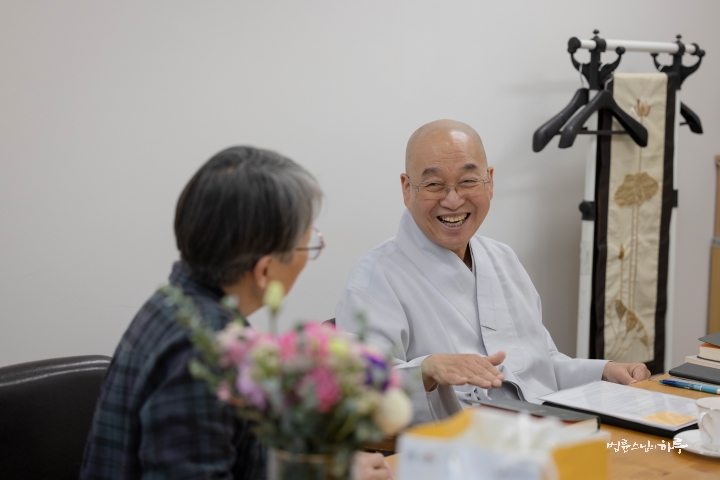
“I believe that in one’s personal life and principles, one should maintain their core values. For example, even if you live in a large house out of necessity, you should keep your personal life – eating, dressing, and sleeping – modest. This is a principle of life that should be upheld. However, when it comes to projects involving others, there’s a need to accommodate public demands to some extent. If you’re too uncompromising, the whole endeavor might fall apart. Whether it’s better to collaborate in this way or not is a decision you must make. You need to judge whether this approach will help expand environmental awareness among the general public, or if you should just live righteously on your own until the end. Neither choice is inherently more correct than the other.”
“I feel like I’m standing at a crossroads.”
“From the beginning, I decided not to accept support from government agencies, and I’ve come this far with that principle. However, as our projects have expanded, we’ve had to construct buildings like this Jungto Social and Cultural Center and engage in overseas relief efforts. This has led to situations similar to what you’re facing, where we have to consider compromising on our principles. So, this is how I’m currently thinking about it.
‘Let’s try to maintain our principles until the day I die. Even if future generations change these principles after I’m gone, I want to uphold them while I’m alive.’
Principles can’t be maintained forever. This is how I’m living by my principles, and you should choose your own path. However, I believe that in one’s personal life, there should be no compromise. In business, some compromise might be necessary. We shouldn’t always view compromise as negative. If an individual compromises on their personal principles, they lose their original intent. But business is different. Because we live in this world with many others, I think we need to accept people’s demands to a certain extent.”
“Thank you for offering your advice over such a long period of time. I will keep it in mind.”
The meeting concluded after 6 PM. Sunim took a commemorative photo with Pastor Kim Min-hae in front of the conference room and saw him off.
“Take care. Feel free to visit anytime if you need anything.”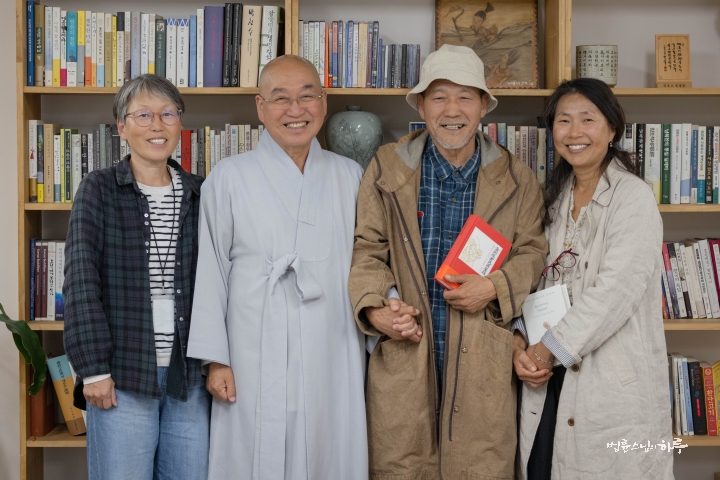
As the sun set, Sunim spent the evening working and wrapping up the day’s tasks.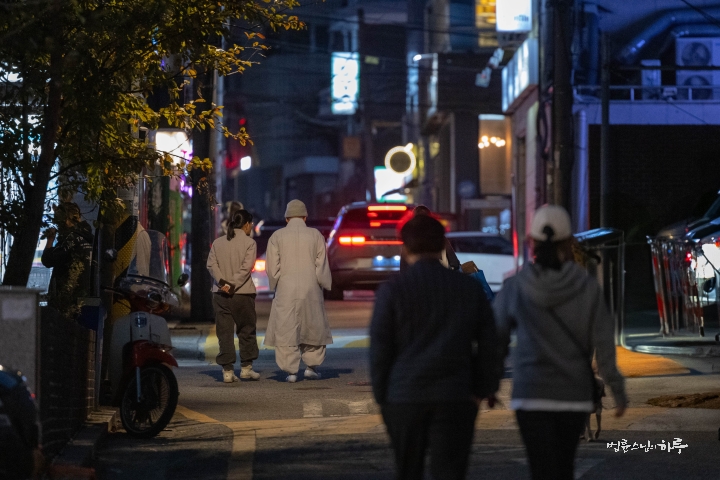
Tomorrow, Sunim is scheduled to conduct live Friday Dharma Q&A sessions in the morning and evening.


